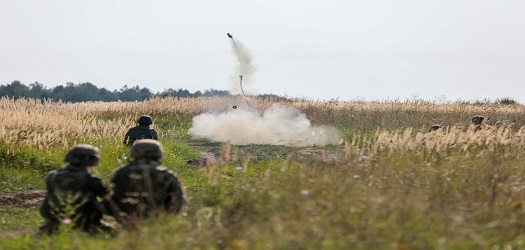Jim Garamone: Military Must Be Ready to Confront Hybrid Threats, Intel Official Says
Hybrid warfare — also known as grey zone conflict or low-intensity conflict — is a reality, and the U.S. military must be ready to confront and deter it, a senior intelligence officer said.
Army Lt. Gen. Karen H. Gibson, the deputy director of national intelligence for national security partnerships, discussed the lessons learned in combating hybrid warfare during the Defense News conference in Arlington, Virginia, today.
Hybrid warfare is the effort to achieve strategic objectives without using significant force, the general said. It is an amorphous definition for an amorphous strategy. Hybrid warfare can include information operations, troop movements, disinformation campaigns, cyberattacks or a combination of all these things. It can also include actual force, as the Russians used in Ukraine.
Hybrid warfare takes many forms. The Chinese efforts in the South China Sea are a form of hybrid warfare. The Russians in Georgia and Ukraine is another. Russia is also continuing efforts to influence European nations with regard to NATO, as the Chinese are working to undermine alliances in the Pacific.

Hybrid warfare is not new, the general said, noting that the Nazis used a form of hybrid warfare before World War II. Sun Tzu, a Chinese general and strategist who lived more than 2,500 years ago, famously said, “The supreme art of war is to subdue the enemy without fighting” and “All warfare is based on deception.”
What is different now, Gibson said, “is the unprecedented ability to use information as an element of warfare with much greater volume, velocity, breadth and depth and precision than previously possible, because global IT systems have made us more connected, more automated and allowed for more precise messaging than ever before.”
This development allows adversaries to promulgate vast volumes of information and the ability to target precise audiences, the general explained. The risks and opportunities will only increase as artificial intelligence developments occur and as the internet of things matures, she added.
Hybrid warfare is appealing to nations or groups that want to challenge the United States, Gibson said, because countries do not wish to be on the receiving end of U.S. conventional military might in any domain. Nations saw the U.S. way of war in operations Desert Shield/Desert Storm, Enduring Freedom and Iraqi Freedom. They want no part of that type of conflict, the general said.
Further, she said, hybrid warfare is low risk, low cost and provides an adversary the opportunity to obfuscate, throwing doubt on who is responsible for these grey zone actions.
Gibson cited the Syrian regime’s use of chemical weapons as an example. “An indicator to us that the regime might be about to use chemicals would be planting information that the opposition has chemicals,” she said. “Then, when there is chlorine in the village, who is to say it came from a barrel bomb?” This type of tactic is a particular problem with consensus-driven organizations such as NATO, she said.
The challenge for U.S. intelligence is identifying, and providing “public attribution of what our adversaries are doing,” Gibson said. Part of this challenge is the fact that the intelligence community does not want to give away sources and methods, she said, and another is simply the time it takes to ensure accuracy.


